The Northern Naturalist #13
Eastern White Pine, A Guide to Winter Finches, Review of White Pine, by John Pastor, News and Notes, including the Northern Naturalist Winter Nature Workshop
Eastern White Pine
As I think back over pleasant trips into the woods, I realize that many of them were in the presence of Eastern White Pine (Pinus strobus). These trees, sometimes giants in our part of the world, give a particular feel to the surrounding forest. The way they filter the light, the rich smell around them in the sunshine, and the solid, columnar presence of their massive trunks evoke my best memories of being outdoors.
White pines can reach over 200 feet tall and endure for over 400 years; old white pines are the tallest trees in our area. They are the only five-needle pine in the North Woods. This means that the needles grow in bundles of five, the same number as the number of letters in the word, “w-h-i-t-e.” Their long cones are also unique here. Their trunks may be buttressed at the base; that is, they grow thick supporting side trunks at the ground that make them steadier and stronger. Their thick, fissured bark can have a purplish cast. Young white pines are smooth and gray.
White pines are easy to pick out in profile. They tower over neighboring trees. Their crowns may be flat, but they are often irregular. Tall white pines are old, exposed trees that may have lost limbs in wind or storms. If the branches are intact, they are long, with a lateral habit, and of varying lengths. The foliage has a silvery cast. The other two pines in the northern boreal forest are Red Pine (Pinus resinosa), which has a stiff, spiky-looking regular crown, and Jack Pine (Pinus banskiana), which is a less massive tree, with irregular, gnarled branches, loaded with cones.
Fallen pine needles break down more slowly than deciduous leaves, so they build up beneath the tree. This gives these areas a cushioned feel under your foot, and a lovely resinous smell, especially when they warm up. The needles are flammable, and in un-managed situations, they contribute to ground fires, which consume the other trees and plants in the understory. The thick lower bark of the pines may be scarred, but it can withstand these ground fires. In this way, the needles help remove competition.
White pine wood is lightweight, strong, and flexible. These characteristics, along with their long, straight trunks, have made white pine a valuable tree for harvest. In the eighteenth century, white pines were shipped from New England to Europe to make masts for the growing naval forces of Western Europe. In the nineteenth and twentieth centuries, white pines fueled the demand for wood for many uses, especially for building houses.
Many of the wooden houses of Chicago and other large, Midwestern cities were made of white pine. The intensive, long-term logging of white pine contributed to a steep decline in their number. In 1906, a disease caused by a fungus, White Pine Blister Rust, entered the United States. This has killed many trees, and until recent years, meant that white pines were not re-planted as part of reforestation efforts. Since Ribes species (gooseberries and currants) are a host needed by the fungus for part of its life cycle, there have been efforts to eradicate Ribes from pine forests. Young men in the Civilian Conservation Corps and other New Deal era agencies did a lot of this kind of work.
White-tailed Deer love to eat young white pines, and the general increase in their population over the past century has also hurt white pines. Finally, the almost universal suppression of wild fires has removed the competitive advantage white pines have in unmanaged forests.
White pines can grow in a variety of soils, including sand and clay. In richer soils, they will grow with hardwoods like maples or oaks. When I come across white pines with maples in my area, I listen (in season) for Black-throated Blue Warblers, since this combination of trees fosters an undercover of plants that the warblers seem to like.
As this year winds down, I wish you a new year of plenty of time in the presence of Eastern White Pines!
A Short Guide to Winter Finches
Why “Winter Finches”? Because a couple of these species, Redpoll and Pine Grosbeak, only come south to us during the winter. Others, Evening Grosbeaks and both species of crossbill, may come and go at different times of year, but most years are more common in winter. The rest may be seen here all year, but their numbers may grow in winter. All of these birds are noticeable in winter, when their loud calls and bright colors enliven the winter landscape.
Redpoll
Redpolls (until recently, two species, “Common Redpoll,” and “Hoary Redpoll,” Redpoll Split/Lump Article) are small, streaky birds with red caps and varying amounts of rosy red on their bodies. They are open country birds that often forage in grassy openings. Some come every year, and in some years, they inundate our area. They all return well to our north by the time warm weather rolls around.
Pine Grosbeak
Pine Grosbeaks are strictly winter-only visitors, and they are among the most beautiful of birds, to my eye. They are large finches, and the males are a rich, rosy red with black, white, and gray wings and tails. Young birds and females are gray with dull orange markings. Their bluebird-like calls are a good sign of their presence.
Evening Grosbeak
Evening Grosbeaks are big yellow-and-black finches. They may nest here in summer, but they are more commonly seen in winter. In the eighties, their numbers swelled in response to spruce budworm outbreaks. When that subsided, so did the numbers of Evening Grosbeaks. They are increasing now, again in the wake of more spruce budworm activity. Learn their loud churr call, and you’ll find more of them.
Red Crossbill
Red Crossbills love pine trees, and unless they are flying overhead, stands of pine are where to look for them. Their colors range from bright red to orange-yellow; red is most common. You need to be quite close to see their crossed bills, which allow them to pry open the scales of pine cones so they can insert their tongues and draw out the seeds. They sometimes use their bills to hold onto twigs while they swing their bodies into new positions on a tree, and this gives the impression that they are crawling around the tree. The best way to tell them from their white-winged relatives is their complete lack of white wing bars. Multiple sub-species of Red Crossbills have been identified, and experts can separate them by their calls.
White-winged Crossbill
White-winged Crossbills have, believe it or not, white bars on their wings. They share the unusual bill structure of Red Crossbills, as well as the range of color in their feathers. White-wings prefer spruce trees and leave the pines to the Red Crossbills. In Minnesota, White-winged Crossbills may nest almost any time of year. Usually, however, they nest to our north.
Pine Siskin
Pine siskins are small, streaky finches. Some birds have noticeable yellow markings, but some are completely drab, or concealing their yellows. Their calls are the best way to detect them. They make a variety of chattering noises, always mixed with buzzy, rising trills. Redpolls sometimes emit rising trills too, but they are not so raspy, nor so long. Pine Siskins nest here.
American Goldfinch
American Goldfinch is described here because of its relation to the other finches, more than than because of its winter activity, although they are here in the winter and fluctuate like their related finch nomads. They nest across much of Northern North America. In winter, they lose their bright gold, and both sexes are sort of yellowy-tan, but they retain their dark wings and white wing bars.
Purple Finch
Purple Finches are medium-sized finches. The males are streaky with a raspberry-red color suffused evenly across their bodies. Female Purple Finches are brown and streaky. The best field mark for females is two, broad parallel stripes across the face.
(Male House Finches, which may be permanent residents in the same areas as Purple Finche, especially urban areas. They are orange-red, and the bright color is patchy on their bodies.)
Learn how to identify the winter finches, and you can fully enjoy the surprise when they appear in your neighborhood.
Review of White Pine: The Natural and Human History of a Foundational American Tree, by John Pastor, Island Press, 2023, 276 pp
John Pastor’s book weaves together a lot of interesting biological information with stories of his own experiences and connections with this tree. The book takes the form of eleven essays which could stand on their own; together, they create a worthy portrait of the “foundational tree of the North Woods,” a title he explains in the book.
John Pastor is Professor Emeritus of Biology at the University of Minnesota-Duluth and past co-chair of the Natural History Section of the Ecological Society of America. He has taught, among other things, Mathematical Ecology and Biological Illustration. His other book, What Should a Clever Moose Eat? Natural History, Ecology, and the North Woods (Island Press, 2016) won the 2017 Northeastern Minnesota Book Award. Both books contain some of his excellent illustrations. I have known John for over 30 years.
The book includes a great introduction to the biology of the White Pine, but it extends well beyond this to include its use as wood, the story of its major role in logging here, New Deal efforts to eradicate White Pine Blister Rust, Henry David Thoreau’s writing, efforts to maintain and restore stands of White Pine, the involvement of the Civilian Conservation Corps, and more.
I enjoyed this breadth of perspective, particularly for a plant that shapes so much of the landscape where I live. The book explains early, key studies of white pine, and tells how their authors discovered what they did. Perhaps my favorite section of the book is about fire. John tells about his direct experience with Bud Heinselman and his research, and what it revealed about fire regimes in different types of forests. (pp. 127-141). Among other methods, Heinselman would paddle a canoe along the shoreline of a northern lake. He learned to tell where different-aged stands met. Younger stands would have a relatively-same appearance; the trees were the same age and had not yet experienced much destruction from wind, snow, or fire. The older stands, on the other hand, looked ragged and much more diverse. Working from this overview of a woodland, Heinselman could then study particular stands and their fire histories.
There’s a lot more to it, but white and red pines can survive ground fires, because they have thick bark, and because they often drop their lower branches, removing fuel that could carry fire up the trunk. Pine needles decompose slowly, and thus build up beneath the trees. This encourages more ground fires, which clear out competitive growth in the underbrush, but don’t destroy the pines. Fires that burn everything in their path, resetting the succession of a forest, occur much less often. This is partly why these pines survive to be the largest trees in many forests.
If you love Eastern White Pine, as I do, you will enjoy this book.
News and Notes
Subscriber Hugh Culver and Donna Koch have launched a nonprofit intended to help get kids outdoors in British Columbia. Check it out: No Small Thing
Notes from Christmas Bird Counts that I worked on:
Sax-Zim: Held on December 16th, 2024. Total Species: 36 (record is 39). Record count of individual birds: 2,995 (old record, 1720). Record counts of Ruffed Grouse, 44; Wild Turkey, 41; White-breasted Nuthatch, 27; Red Crossbill, 31; White-winged Crossbill, 905; Redpoll, 589; Purple Finch, 154. Red-tailed Hawk was new for the count. Great winter finch year. Three Great Gray Owls, four Black-backed Woodpeckers.
Duluth: Held on December 14th, 2024. Total Species: 57 (average). 10,350 individual birds counted. Record counts of Common Goldeneye, 940; Red-bellied Woodpecker, 30; American Tree Sparrow, 7. Trumpeter Swan was a new species for the count.
My St. Louis County, Minnesota Big Year, 2025
I have decided to do a St. Louis County Big Year. This means identifying as many species as possible within the county in the calendar year. In the next issue, I’ll write about plans, prospects, and my progress, as it will already be a few days into 2025.
Those crazy pigeons: Yesterday, as we drove across Duluth’s aerial lift bridge,
we noticed a group of small birds on the water. Out of the corner of my eye, I thought, “Goldeneyes.” When we got an unobstructed view, we could see that there was a large group of Rock Pigeons (Columba livia) jammed together, perched on a six-foot chunk of ice. Some were flying down from the framework of the bridge to the ice. It looked as if there were just sitting there. No ducks to be found. No food in sight. Why do this? My best is idea is that it was a rare sunny day, and they were playing around.
That’s it for this year! I am looking forward to a full new year of writing about nature in the North Woods. I am so grateful to all of you for reading and subscribing!
Thank you, and Happy New Year!
“My pipe is out, my glass is dry;
My fire is almost ashes too;
But once again, before you go,
And I prepare to meet the New:
Old Year! a parting word that’s true,
For we’ve been comrades, you and I—
I thank God for each day of you;
There! bless you now! Old Year, good-bye!”
—from The Passing of the Year, by Robert Service

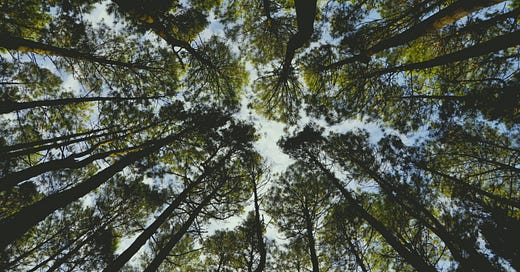



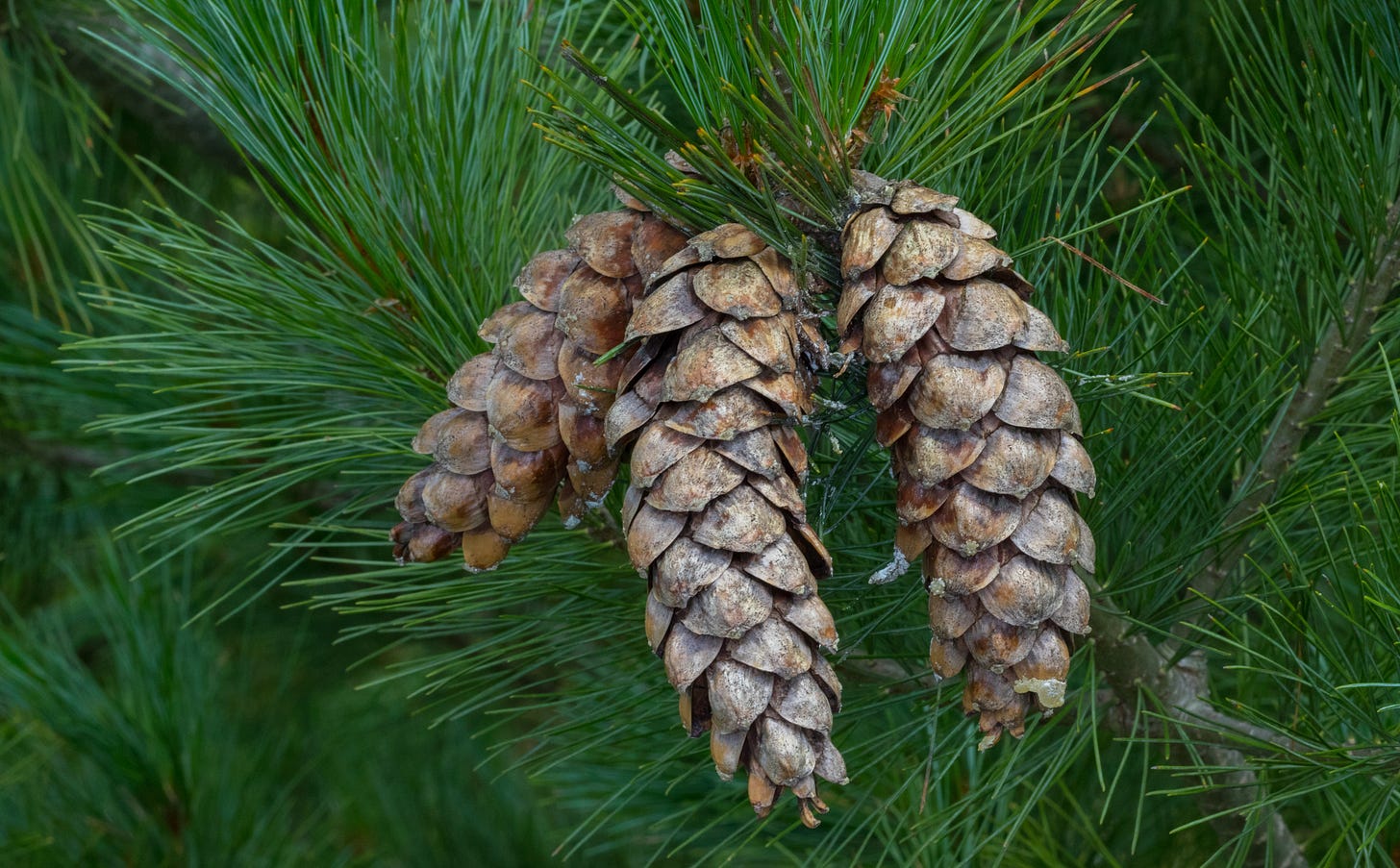


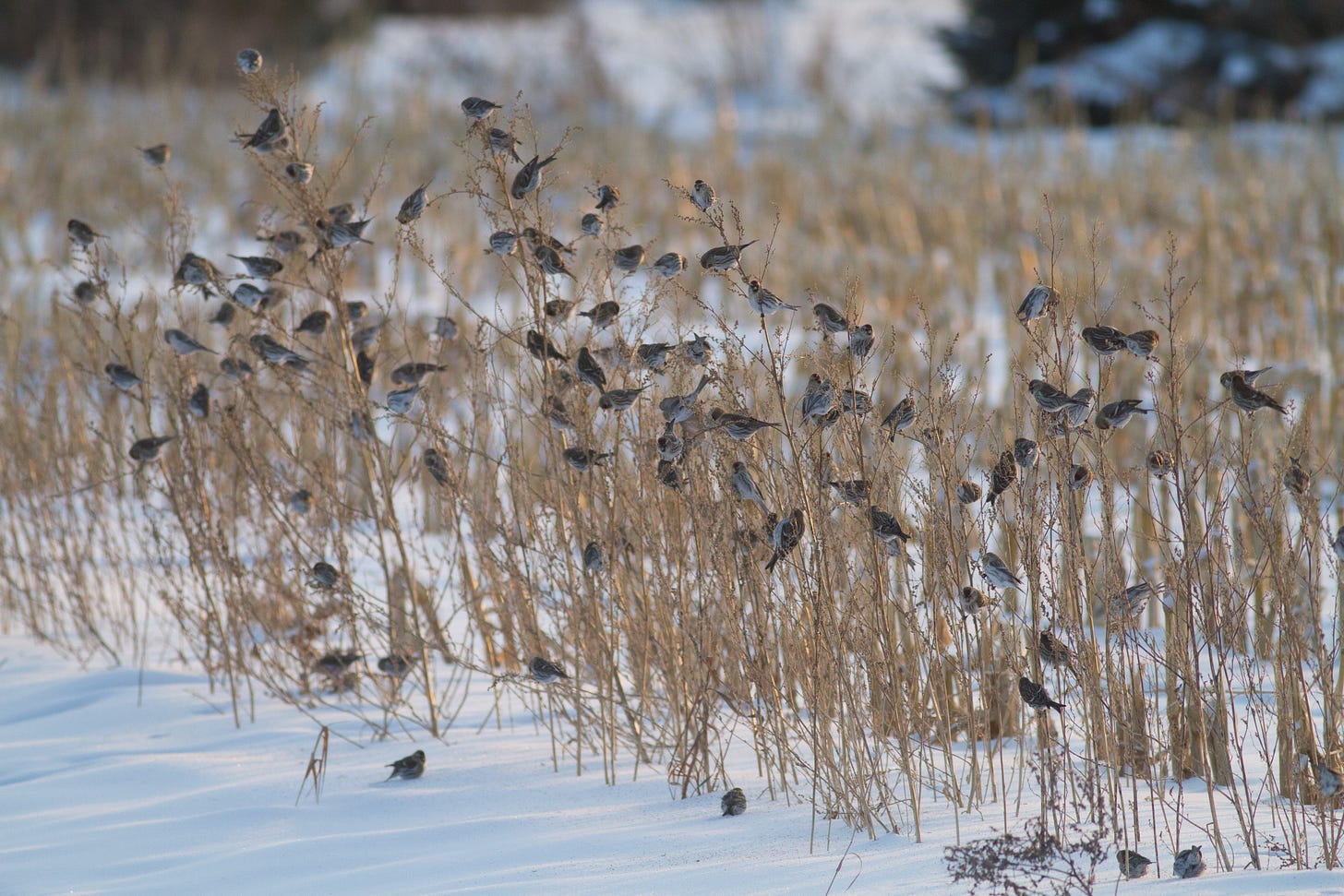
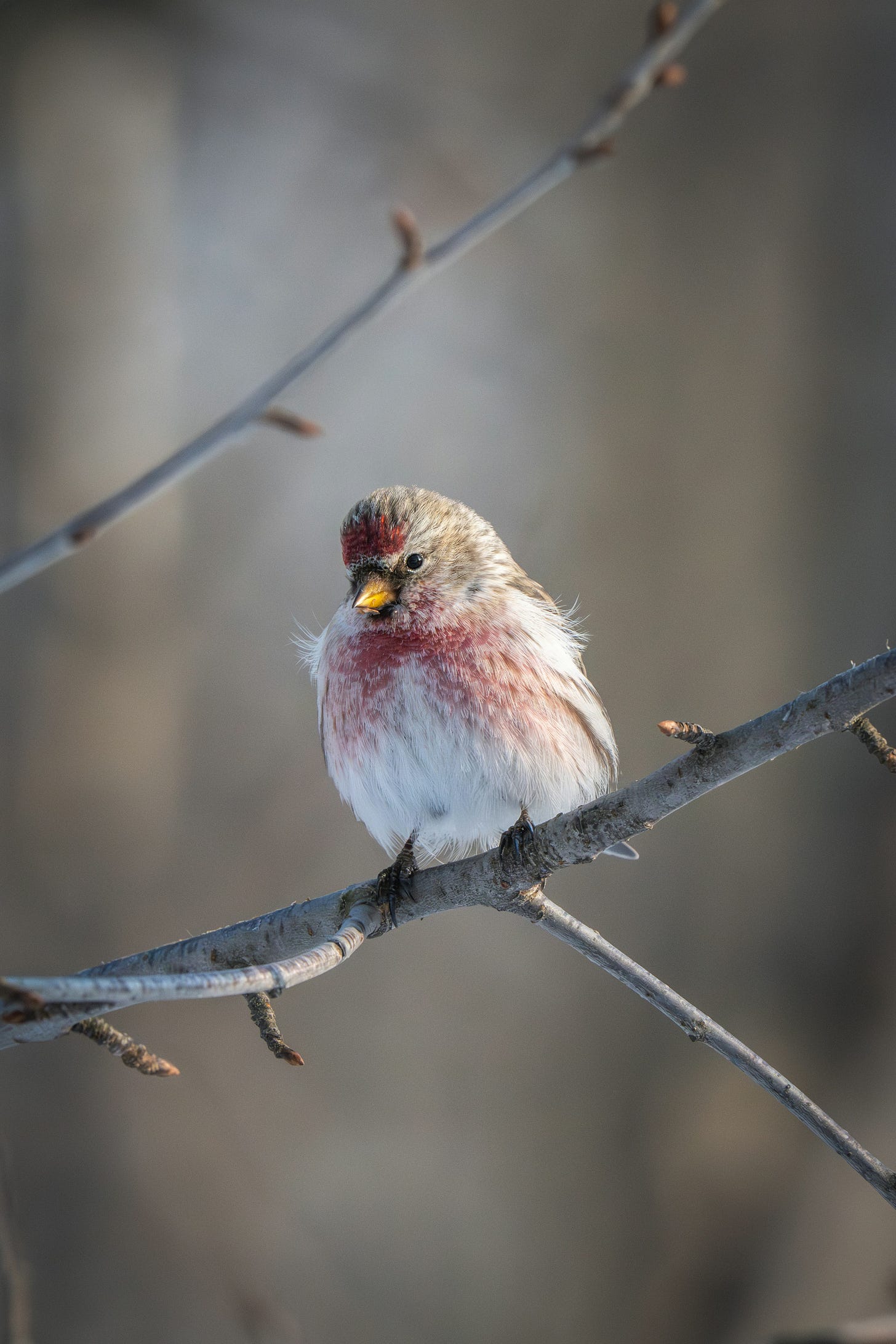
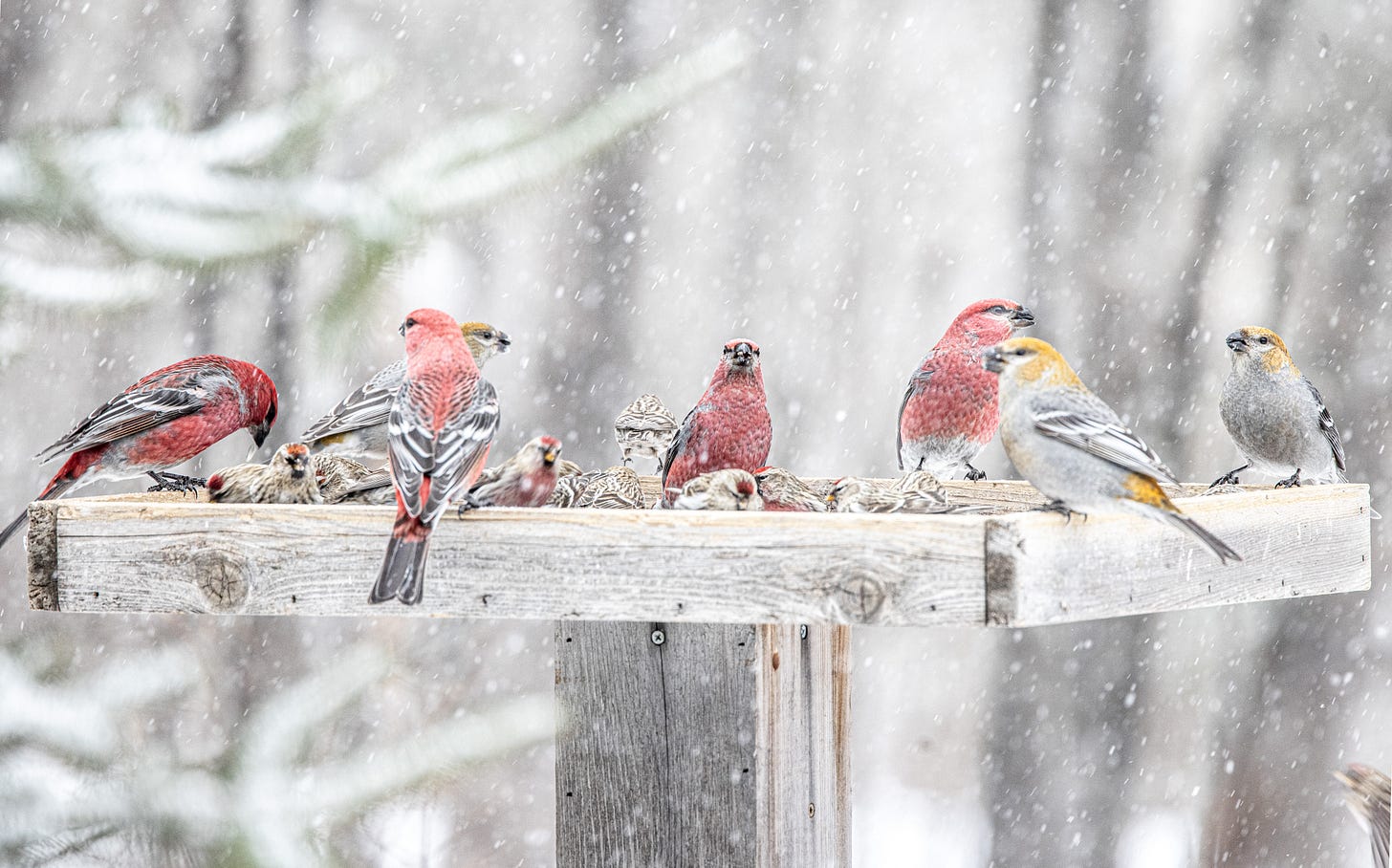
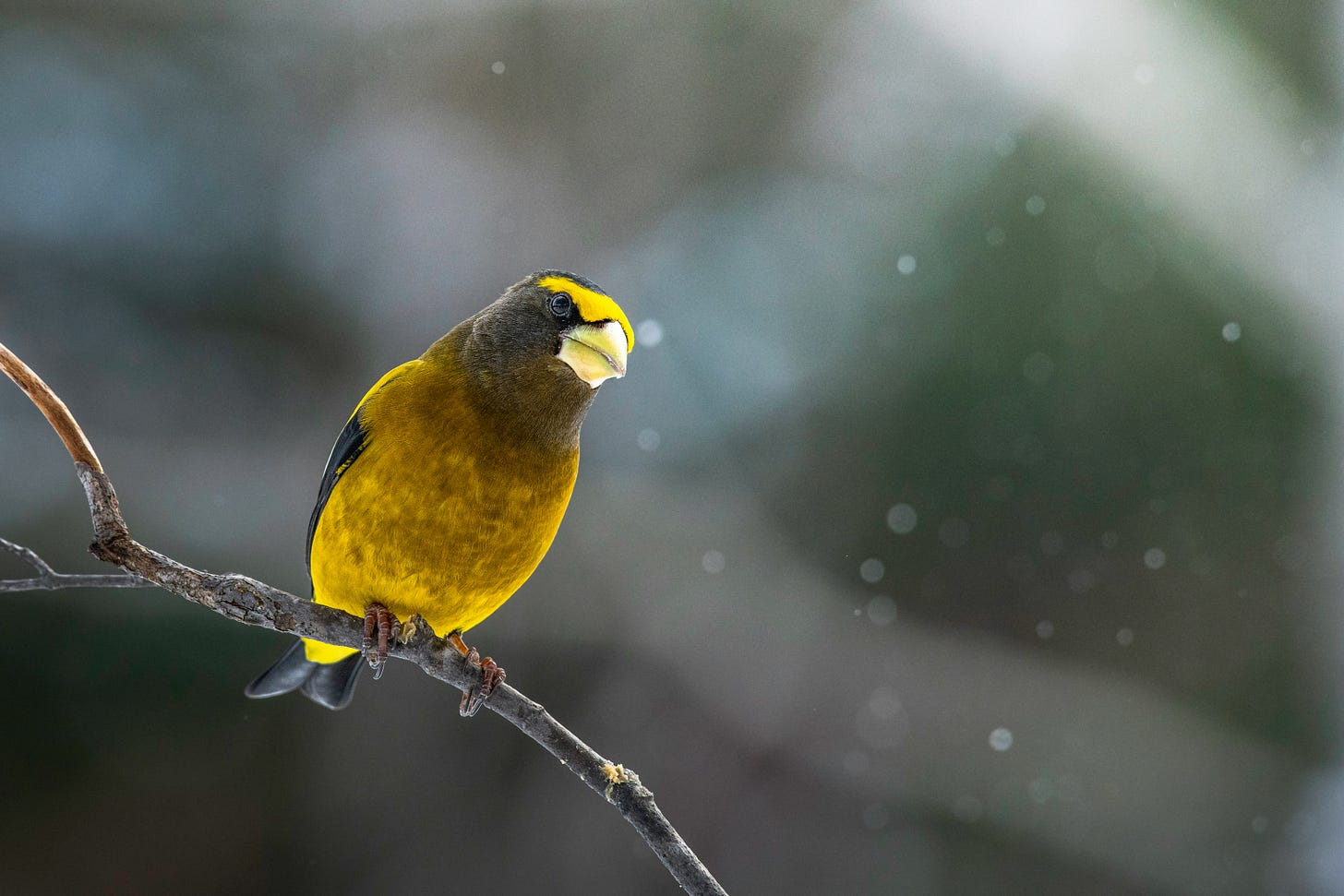

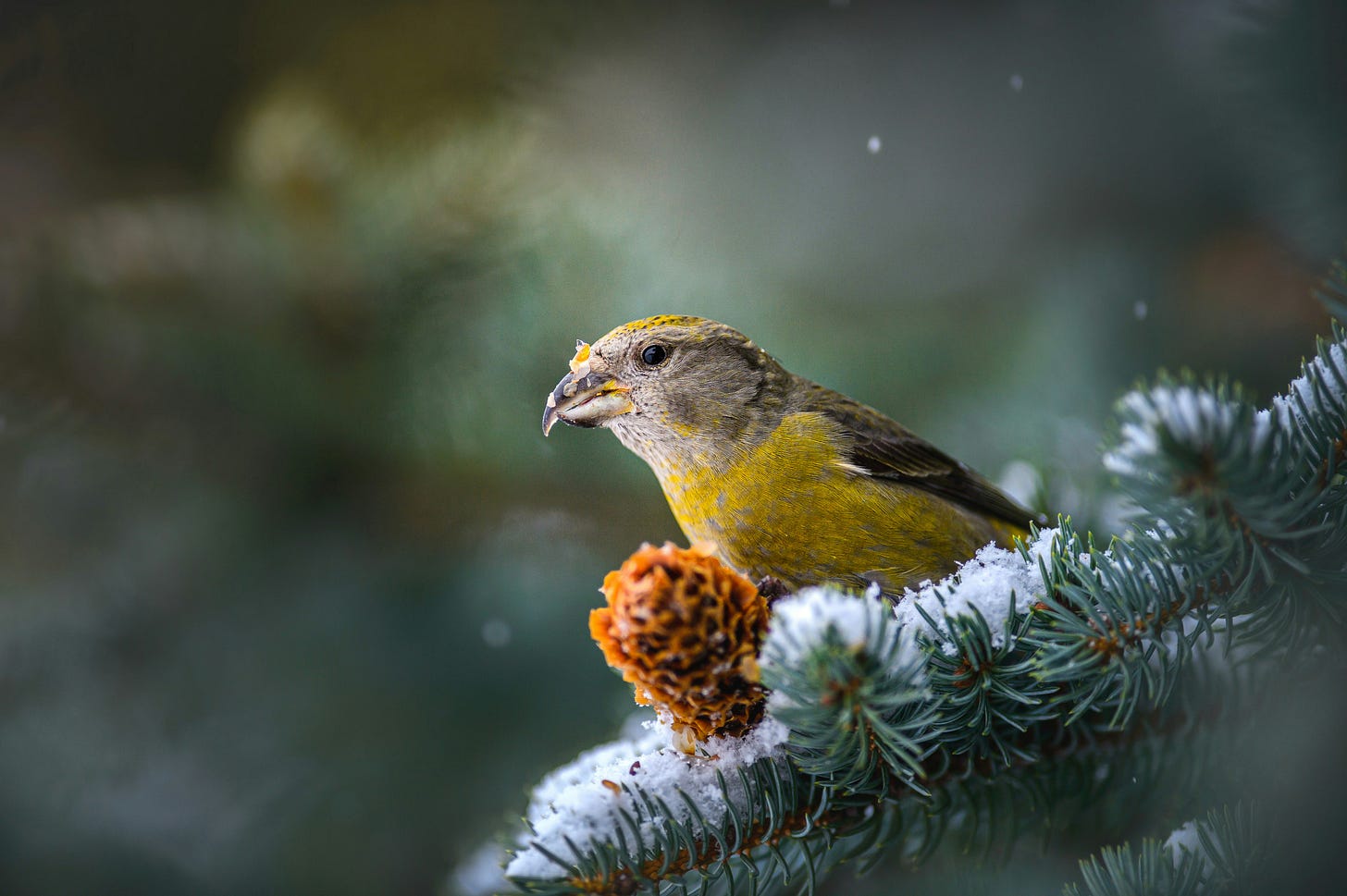
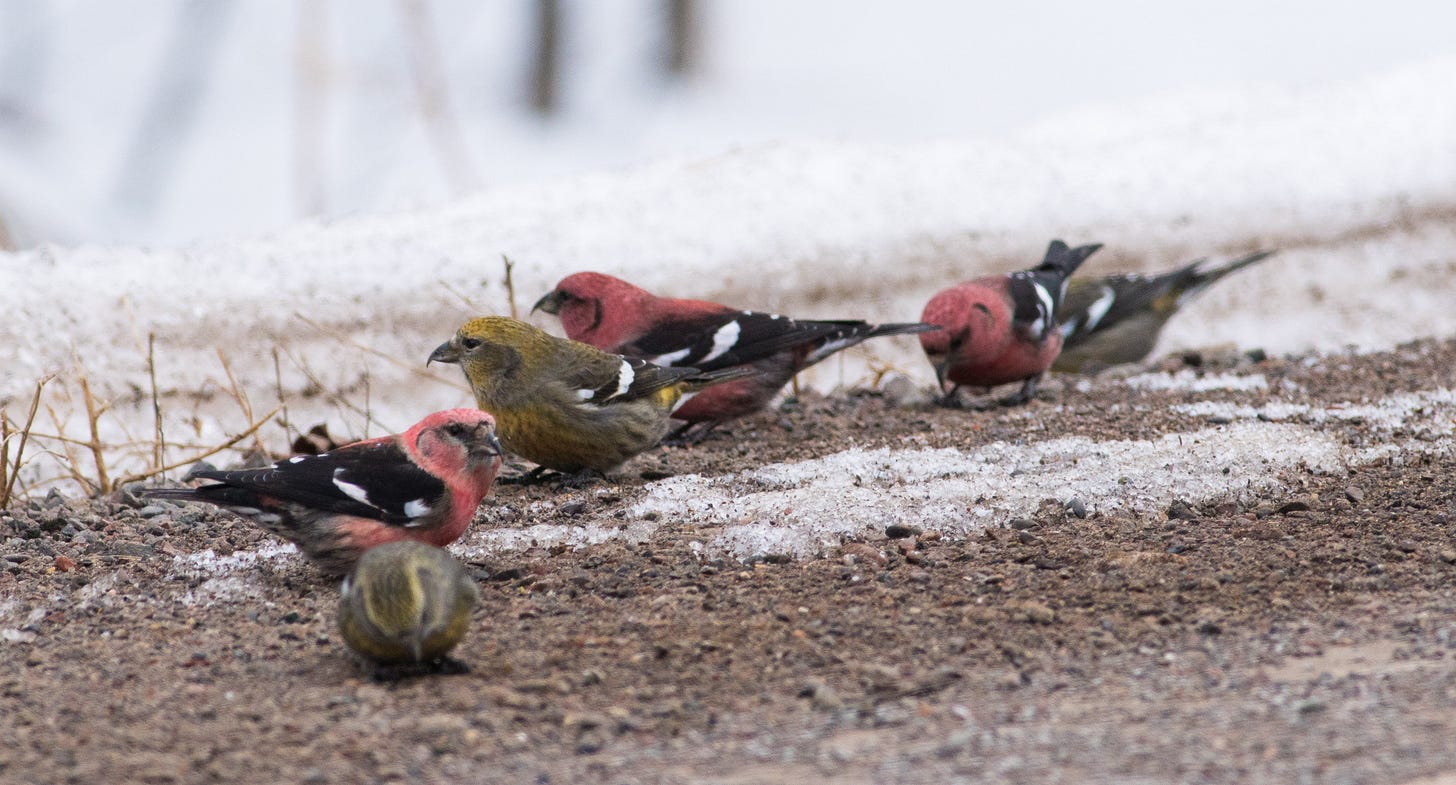
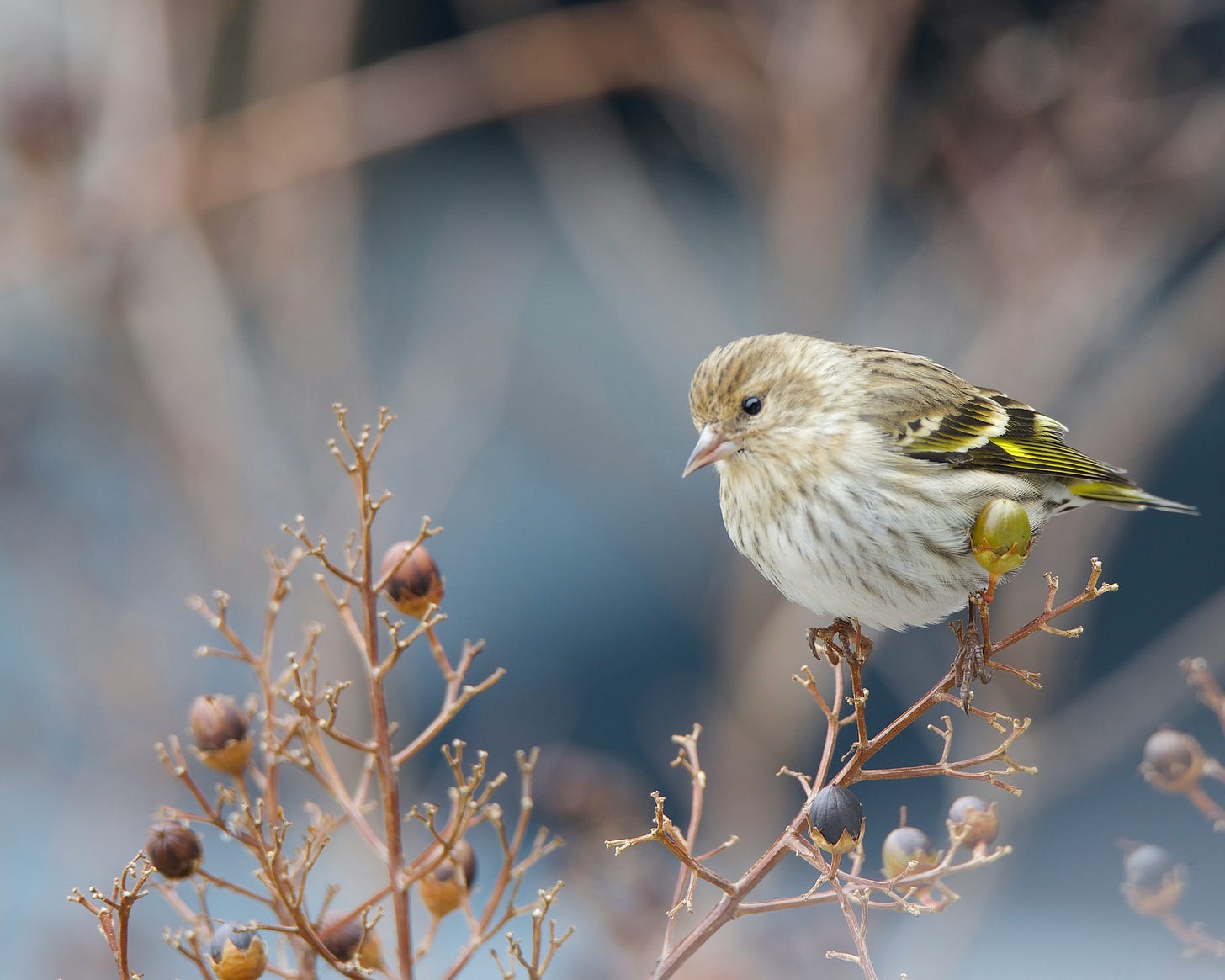
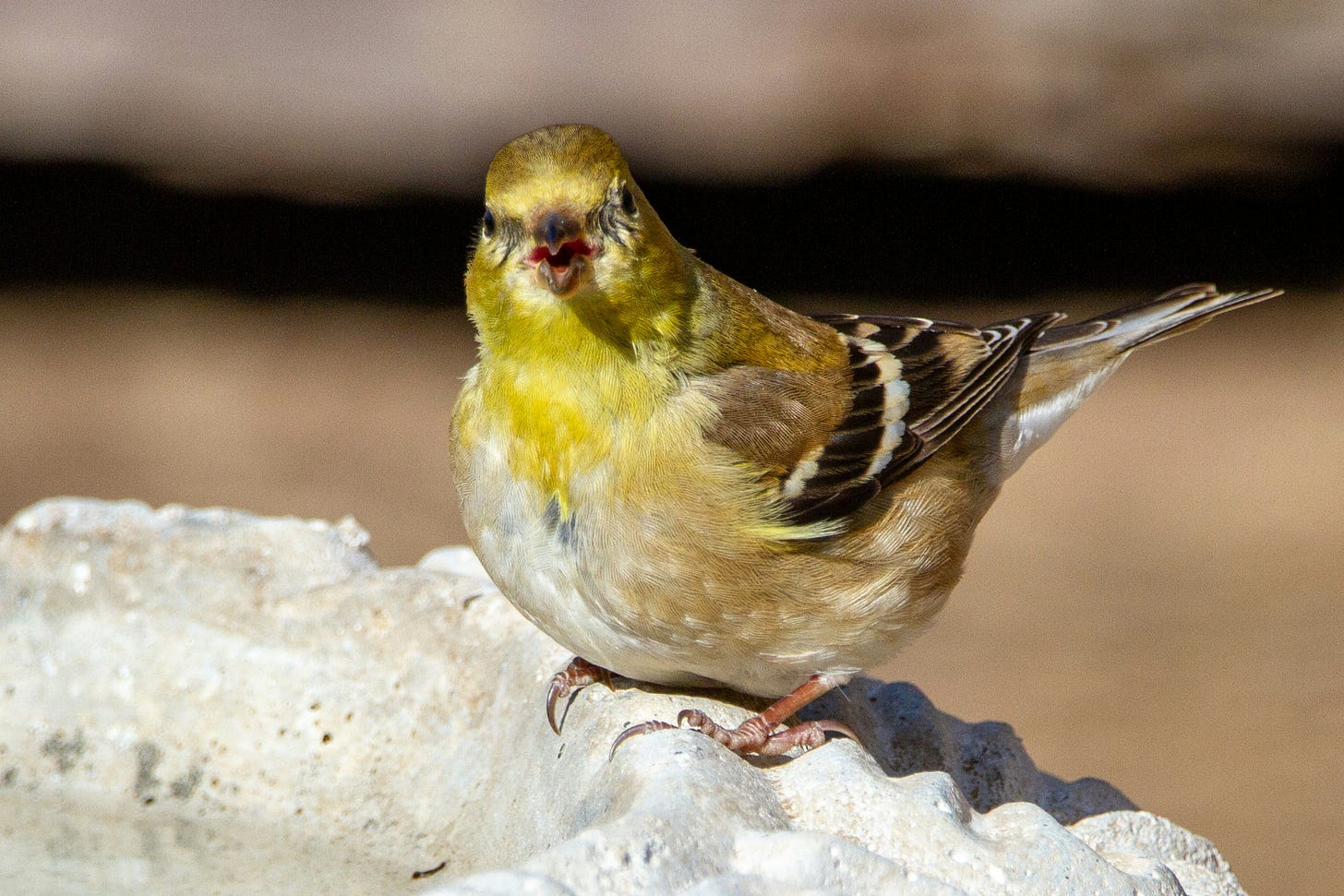
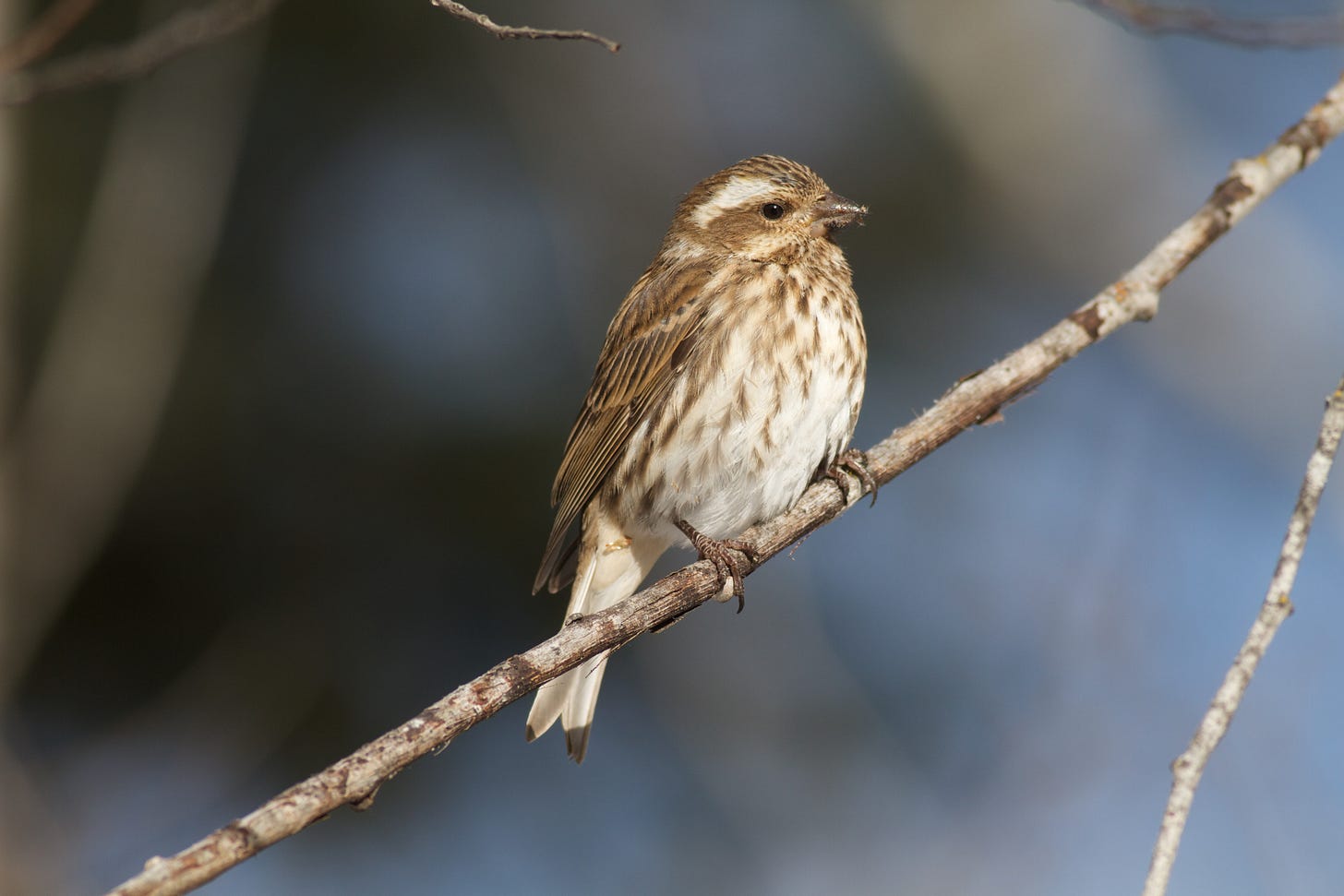





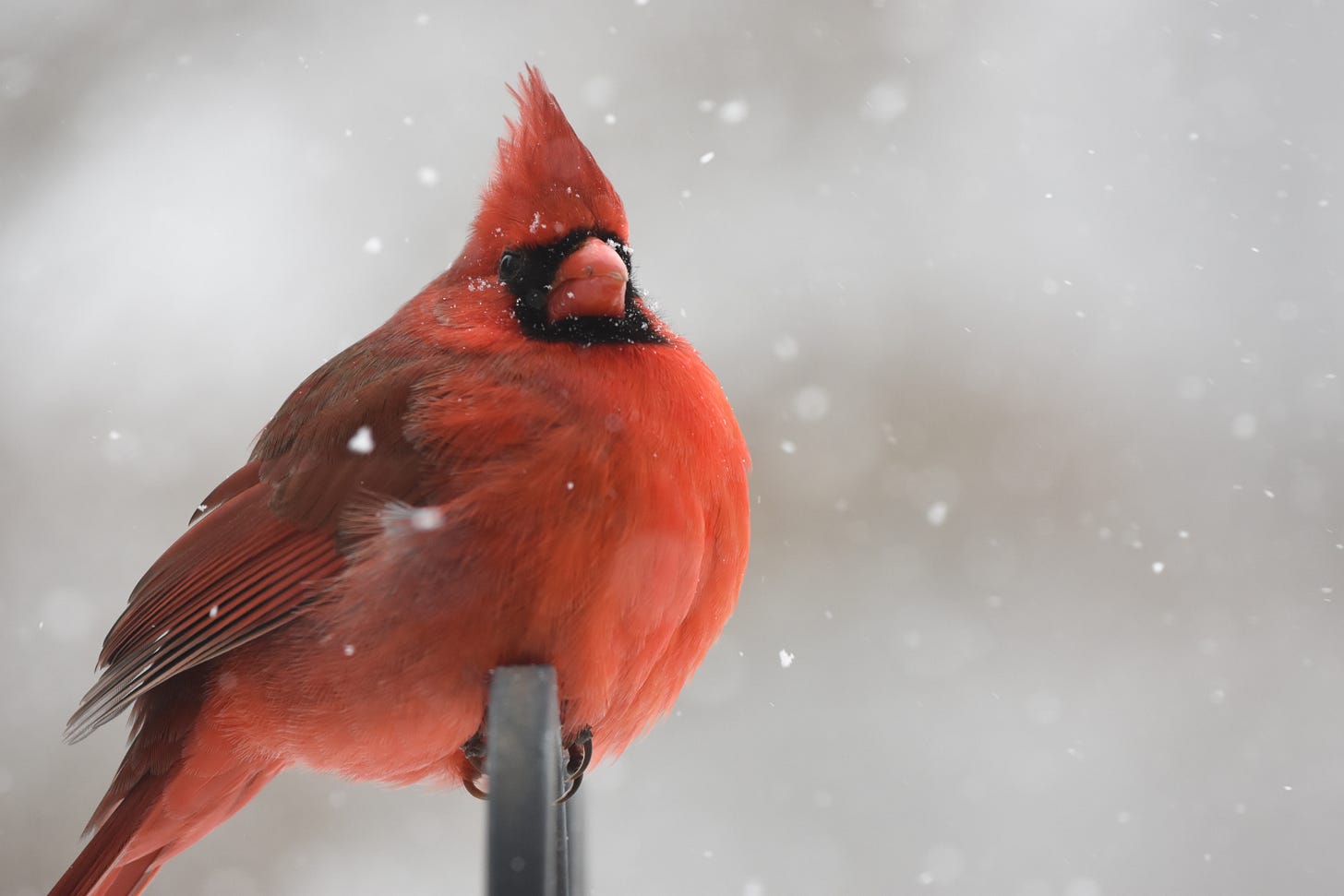

I've enjoyed reading the past two issues very much! It's inspired me to get outside more throughout this winter. Will there be any more upcoming Zoom gatherings? I missed the one on January 8 (I got behind on my reading. Shame on me!)
I love how many different finches there are. They are so beautiful! Some of the ones in your post I hadn’t heard about before, so I learned something new. Thank you!